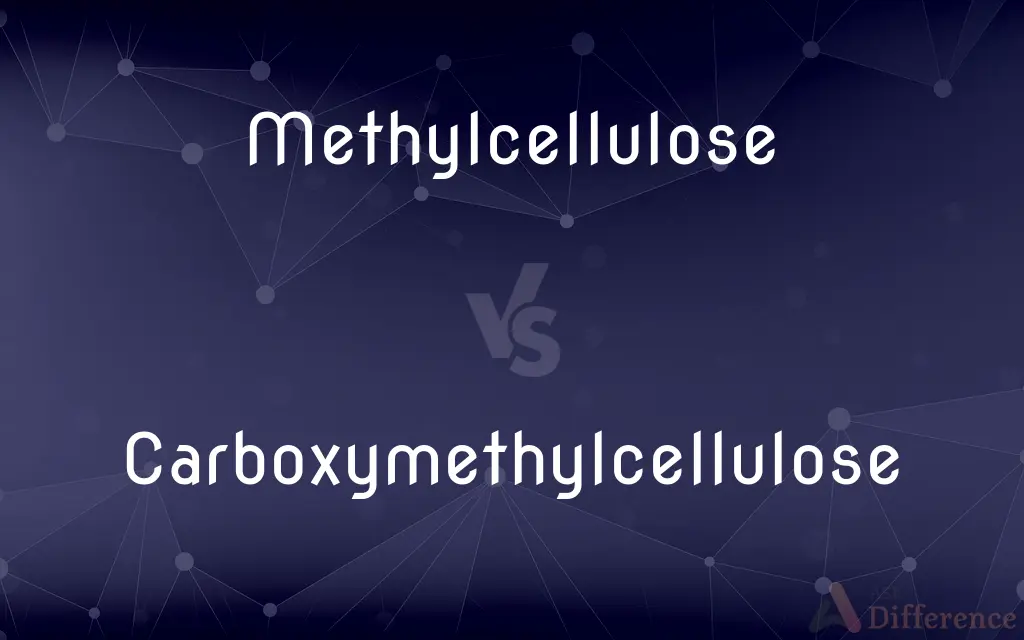Methylcellulose vs. Carboxymethylcellulose — What's the Difference?
By Fiza Rafique & Urooj Arif — Updated on March 27, 2024
Methylcellulose is a chemical compound used as a thickener, while carboxymethylcellulose is its carboxylated derivative with more applications.

Difference Between Methylcellulose and Carboxymethylcellulose
Table of Contents
ADVERTISEMENT
Key Differences
Methylcellulose (MC), derived from cellulose, is a chemical compound that acts as a thickener, emulsifier, and film-former in various applications, including food, pharmaceuticals, and construction. It is water-soluble, forming a gel when heated, and is unique for its thermal gelation properties. Carboxymethylcellulose (CMC), also derived from cellulose, is a carboxylated derivative of methylcellulose. It shares similar uses with MC, such as in food and pharmaceuticals, but its carboxyl groups make it more versatile. CMC offers higher viscosity and better stability, making it preferable in more demanding applications.
While both compounds are used as thickeners and stabilizers, their chemical structures influence their solubility and interaction with other substances. MC is soluble in cold water and gels upon heating, which is useful in foods and products that require temperature-sensitive gelation. CMC, with its carboxyl groups, provides higher viscosity solutions at lower concentrations and is more effective in a wider range of temperatures and pH levels.
In the pharmaceutical industry, MC is often used as a laxative and as a disintegrant in tablets, whereas CMC's higher viscosity and better mucoadhesiveness make it suitable for use in eye drops, as a binder in tablets, and in wound care products.
In food applications, MC is used to improve texture and retain moisture in baked goods, while CMC is often found in ice cream, where it prevents ice crystal formation, and in gluten-free baking, where it helps mimic the texture of gluten.
Comparison Chart
Composition
Derivative of cellulose.
Carboxylated derivative of cellulose.
ADVERTISEMENT
Solubility
Soluble in cold water, gels upon heating.
Soluble in both cold and hot water, more versatile.
Applications
Thickeners, emulsifiers, film-formers.
Thickeners, stabilizers, higher viscosity.
Industries
Food, pharmaceuticals, construction.
Food, pharmaceuticals, personal care.
Unique Properties
Thermal gelation.
Higher viscosity, better stability.
Compare with Definitions
Methylcellulose
A chemical compound used as a thickener.
Methylcellulose is added to ice cream to improve its texture.
Carboxymethylcellulose
A derivative of cellulose used for its thickening properties.
Carboxymethylcellulose is added to sauces to prevent separation.
Methylcellulose
Employed in pharmaceuticals as a laxative.
Methylcellulose is a key ingredient in over-the-counter laxatives.
Carboxymethylcellulose
Offers higher viscosity solutions.
CMC is preferred in eye drops for its ability to create a protective film over the eye.
Methylcellulose
A water-soluble polymer that gels on heating.
Methylcellulose's unique gelling property is utilized in vegan cooking to mimic meat textures.
Carboxymethylcellulose
Functions as a stabilizer in food products.
Ice cream manufacturers use carboxymethylcellulose to prevent ice crystals.
Methylcellulose
Used in the construction industry as a viscosity modifier.
Methylcellulose solutions are used to improve the properties of cement mixes.
Carboxymethylcellulose
Used in non-food applications for its water-retention capabilities.
CMC is utilized in personal care products like toothpaste for its thickening effect.
Methylcellulose
Acts as a binder in tablet formulations.
Tablets often contain methylcellulose to ensure they disintegrate properly.
Carboxymethylcellulose
Has applications in wound care products.
Carboxymethylcellulose is found in wound dressings for its moisture-retaining properties.
Methylcellulose
A powdery substance that is prepared synthetically by the methylation of natural cellulose, swells in water to form a gel, and is used as a food additive, bulk-forming laxative, emulsifier, and thickener.
Carboxymethylcellulose
A derivative of cellulose whose sodium salt is used in the manufacture of processed foods as a stabilizing and emulsifying agent, in drugs to add viscosity and lubrication, and in sizing paper and textiles.
Methylcellulose
(organic chemistry) A white powdery substance, obtained by the methylation of cellulose, that swells in contact with water to form a gel; it has many industrial applications.
Carboxymethylcellulose
(organic chemistry) The product of the reaction of cellulose with chloroacetic acid; it is used as a thickener and to stabilize emulsions
Common Curiosities
What role does carboxymethylcellulose play in pharmaceuticals?
CMC is used in pharmaceuticals for its high viscosity and mucoadhesiveness, beneficial in eye drops and wound care.
How do these compounds affect the texture of food?
They improve texture and consistency, with MC providing thermal gelling properties and CMC enhancing stability and viscosity.
Are methylcellulose and carboxymethylcellulose safe?
Both compounds are considered safe for use in many applications, including food and pharmaceuticals, as approved by regulatory agencies.
Why is carboxymethylcellulose preferred in some applications over methylcellulose?
Its carboxyl groups provide higher viscosity and better stability across a wider range of temperatures and pH levels.
Are there any known allergies to these substances?
Allergies are rare, but as with any substance, sensitivity can vary among individuals.
What makes methylcellulose and carboxymethylcellulose different?
The key difference is in their chemical structure; CMC has carboxyl groups that MC does not, affecting their solubility and applications.
Can both be used in food products?
Yes, both are used in food products as thickeners and stabilizers, but CMC is often chosen for its higher viscosity and stability.
Why is methylcellulose unique in its gelling properties?
MC gels upon heating and dissolves in cold water, a property utilized in temperature-sensitive applications.
Can either compound be used as a dietary supplement?
MC is commonly used as a laxative in dietary supplements, while CMC's role in supplements is more limited to its thickening properties.
What environmental considerations exist for these compounds?
Both are derived from cellulose, a renewable resource, but their production and disposal should be managed to minimize environmental impact.
Share Your Discovery

Previous Comparison
Happy vs. Content
Next Comparison
Dervish vs. SufiAuthor Spotlight
Written by
Fiza RafiqueFiza Rafique is a skilled content writer at AskDifference.com, where she meticulously refines and enhances written pieces. Drawing from her vast editorial expertise, Fiza ensures clarity, accuracy, and precision in every article. Passionate about language, she continually seeks to elevate the quality of content for readers worldwide.
Co-written by
Urooj ArifUrooj is a skilled content writer at Ask Difference, known for her exceptional ability to simplify complex topics into engaging and informative content. With a passion for research and a flair for clear, concise writing, she consistently delivers articles that resonate with our diverse audience.
















































